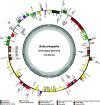Characterization of the complete plastid genome of Butia eriospatha (Arecaceae)
- PMID: 32926069
- PMCID: PMC7488953
- DOI: 10.1590/1678-4685-GMB-2020-0023
Characterization of the complete plastid genome of Butia eriospatha (Arecaceae)
Abstract
Butia eriospatha is an endemic palm species from the Atlantic Rainforest in Brazil, a biodiversity hotspot. This species is currently listed in the IUCN red list as vulnerable and lacks specific plastid markers for population genetics studies. In addition, the evolutionary relationship within the genus Butia is not yet well resolved. Here, we sequenced and characterized the complete plastid genome (plastome) sequence of B. eriospatha. The complete plastome sequence is 154,048 bp in length, with the typical quadripartite structure. This plastome length and genes content is consistent with other six species from tribe Cocoseae. However, the Inverted Repeat (IR) borders show some variation among the analyzed species from this tribe. Species from the Bactridinae (Astrocaryum and Acrocomia) and Elaeidinae (Elaeis) subtribes present the rps19 gene completely duplicated in the IR region. In contrast, all plastomes sequenced from the subtribe Attaleinae (Butia, Cocos, Syagrus) present one complete CDS of rps19 and one partial copy of rps19. The difference in the IR/LSC junctions between Attaleinae and the sister clades Bactridinae + Elaeidinae might be considered an evolutionary signal and the plastome sequence of B. eriopatha may be used in future studies of population genetics and phylogeny.
Figures


References
-
- Amiryousefi A, J Hyvönen, Poczai P. IRscope: An online program to visualize the junction sites of chloroplast genomes. Bioinformatics. 2018;34:3030–3031. - PubMed
-
- Correa LB, Barbieri RL, Rossato M, MV Büttow, Heiden G. Karyological characterization of Butia (Arecaceae) palm trees. Rev Bras Frutic. 2009;31:1111–1116.
-
- Deble LP, Marchiori JNC, Alves FS, AS Oliveira-Deble. Survey on Butia (Becc.) Becc. (Arecaceae) from Rio Grande do Sul state (Brazil) Balduinia. 2011;30:3–24.
Internet Resources
-
- Heiden G, PE Ellert-Pereira, MP Eslabão. Butia in Flora do Brasil 2020 under construction. 2020. http://floradobrasil.jbrj.gov.br/reflora/floradobrasil/FB26574 (accessed June 2020)
-
- Palmweb - Palms of the world online. http://www.palmweb.org/node/2 (accessed December 2019).
-
- WFO. Butia (Becc.) Becc. 2019. http://www.worldfloraonline.org/taxon/wfo-4000005828 (accessed December 2019).
LinkOut - more resources
Full Text Sources
Miscellaneous

